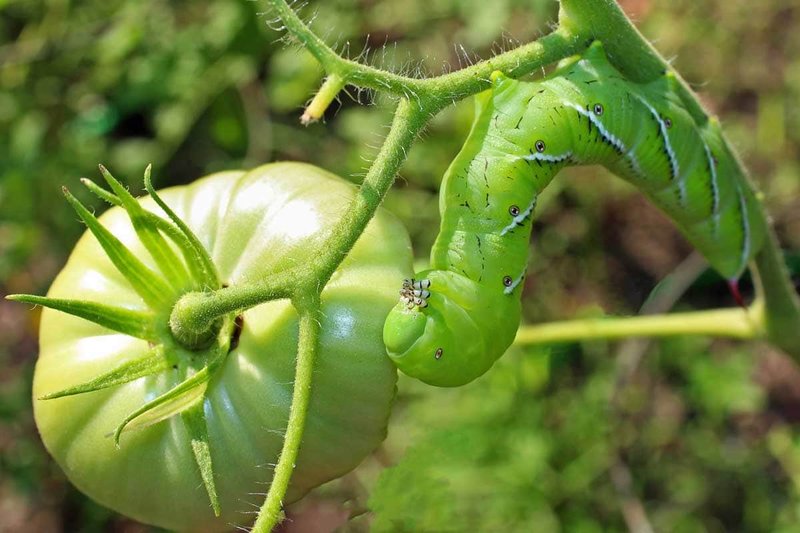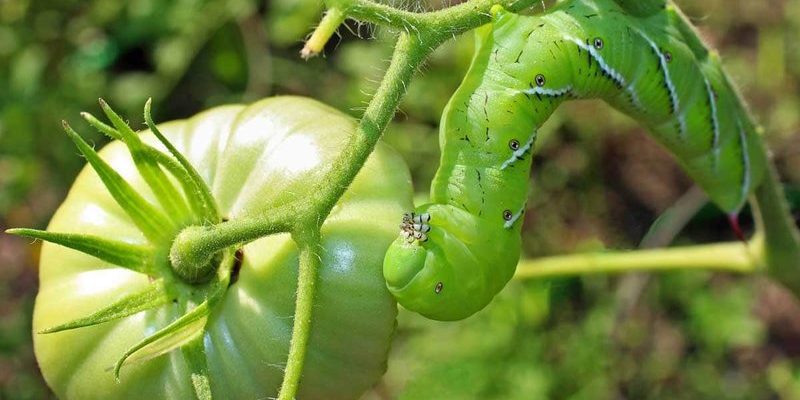
Hornworms can be tricky to spot at first. They blend in with the green leaves of your plants, making them seem nearly invisible. But with a keen eye, you can recognize the symptoms of their damage. Knowing what to look for will help you take action quickly. This way, you can enjoy fresh, juicy tomatoes instead of lamenting over a lost crop.
What are Hornworms?
Hornworms are the larvae of certain moths, primarily the five-spotted hawk moth and the tobacco hornworm. They can grow up to 4 inches long and are often bright green, which helps them camouflage against the tomato leaves. You might be wondering why they’re so notorious among gardeners. Hornworms can munch through an entire plant in just a few days, leaving you with little more than stems.
Besides their size, what makes hornworms particularly challenging is their rapid growth. One moment they’re small and almost unnoticeable, and the next, they’ve turned your lush green plant into a skeleton of its former self. This quick growth means that checking your plants regularly is crucial. If you let them go unchecked, you could face serious damage in no time.
Visible Damage to Leaves
One of the most immediate signs of hornworm damage on tomato plants is the leaves. These pests love to chow down on young, tender foliage. When you check your plants, look for:
- Missing Foliage: Large chunks of leaves may be completely chewed away, giving your plants a ragged appearance.
- Irregular Holes: Instead of neat little bites, you’ll see uneven holes torn into the leaves, as hornworms tend to munch indiscriminately.
- Wilting Leaves: As hornworms devour the leaves, the whole plant may begin to droop and show signs of stress.
It’s almost like a slow-motion disaster unfolding in your garden. If you’re not vigilant, those beautiful green plants could quickly become a feast for these hungry caterpillars. Regular checks allow you to catch issues before they escalate.
Signs of Hornworms on Stems and Fruits
Beyond leaves, hornworms can also cause damage to the stems and even the fruit of your tomato plants. Here’s what you might see:
- Chewed Stems: Look for signs of nibbling on the stems themselves. This can weaken the plant, making it more susceptible to disease.
- Fruit Damage: If hornworms reach the fruit stage, they’ll leave behind unsightly holes or marks on your tomatoes.
- Dark Excrement: You may notice tiny black droppings near the base of your plants or on the leaves. This is a clear sign that hornworms are nearby.
These signs can be particularly disheartening, especially if your tomatoes are starting to ripen. It’s like finding a hole in your favorite shirt right before an event! Pay attention to these symptoms to protect your harvest.
Identifying Hornworms on Your Plants
So, how do you catch these sneaky pests in action? Look for a few telltale signs:
- Presence of Hornworms: These caterpillars can often be found clinging to the underside of leaves or hidden in the foliage. Check during the day, as they tend to hide away at night.
- Green Coloration: Their bright green color can help them blend in, but if you look closely, you can see them munching away.
- Frass (Droppings): As mentioned earlier, the dark droppings are not just unsightly; they’re indicators that hornworms are active in your garden.
If you spot a hornworm, you need to act fast. These pests can reproduce quickly, adding to your problems if left unchecked. Being proactive will save your tomatoes from being entirely devoured.
Comparing Hornworms to Other Pests
It’s essential to understand how hornworm damage differs from other pests. For instance, aphids tend to suck the sap from plants, causing them to wilt and yellow. In contrast, hornworms directly munch on the plant, leading to visible holes and missing leaves.
Other pests, like spider mites or whiteflies, often leave behind a web or a powdery substance. Hornworms don’t do that. Instead, they leave visible damage that’s hard to miss. Recognizing these differences can help you target your pest control efforts more effectively.
How to Manage Hornworm Infestations
When it comes to dealing with hornworms, prevention and action are key. Here are some effective strategies:
- Regular Monitoring: Check your plants daily, especially during the growing season. The sooner you catch them, the better.
- Handpicking: If you spot a hornworm, pick it off and dispose of it. This might seem gross, but it’s one of the most effective methods.
- Natural Predators: Encourage beneficial insects like parasitic wasps. They’ll help control hornworm populations naturally.
- Insecticidal Soap: If the infestation becomes severe, consider using organic insecticidal soap as a last resort. Always follow the manufacturer’s instructions.
Here’s the thing: managing hornworms doesn’t have to be a nightmare. With a little diligence and some simple strategies, you can protect your beloved tomato plants from their damaging appetite.
The Importance of Early Intervention
Timing is everything when it comes to dealing with hornworm damage. If you catch these pests early, you can easily prevent severe damage to your plants. It’s like catching a cold—if you treat it right away, it’s easier to handle. Waiting until the infestation is widespread can lead to loss of your entire crop.
Early intervention means being attentive to your plants and regularly inspecting for signs of trouble. Look every day or every other day, especially if your plants are young and vulnerable. Trust me; the effort you put in now will pay off later when you’re enjoying delicious tomatoes straight from the garden.
In conclusion, keeping an eye on your tomato plants for signs of hornworm damage is essential for a thriving garden. By recognizing the symptoms early and implementing management strategies, you can protect your plants and ensure a successful harvest. Enjoy the fruits of your labor and the satisfaction that comes with growing your own food. Happy gardening!

